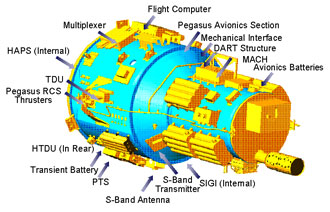Every day small asteroids hit the Earth’s atmosphere and burn up before they reach the surface. One of the great existential threats to the human race is the possibility that a big asteroid could hit the Earth and devastate the ecosystem of the entire planet. Thousands of asteroids regularly cross the orbit of the Earth and pose a serious threat. There are a few that could cause great damage and many that could cause some damage.
A popular theme for summer blockbuster movies has been desperate efforts by people on Earth to divert or destroy an inbound asteroid. As a matter of fact, this fall, there will be a miniseries on television with just this theme. There is historical evidence of meteor strikes that influenced earlier civilizations. Up until now, all we could do was hide and hope we survived. Now, however, for the first time in the history of humanity on this planet, it is possible that the human race might be able to divert or destroy a major asteroid bound for the Earth.
NASA has just announced that they will conduct a test to change the course of a small asteroid that is heading for the Earth. The test is called Double Asteroid Redirection Test (DART). The DART project is a joint exercise between NASA and the John Hopkins Applied Physics Laboratory located in Maryland.
NASA's planetary defense officer in Washington said that "DART would be NASA's first mission to demonstrate what's known as the kinetic impactor technique -- striking the asteroid to shift its orbit -- to defend against a potential future asteroid impact. This approval step advances the project toward an historic test with a non-threatening small asteroid."
The target for DART is a binary asteroid system named Didymos. Didymos A is a large asteroid orbited by Didymos B which is much smaller. In October of 2022, Didymos will make a close approach to the Earth. NASA will launch a satellite the size of a refrigerator towards Didymos B. The satellite will be traveling at three and seven tenths miles per hour when it slams into the asteroid.
The idea behind the DART project is to use a high velocity satellite to hit an incoming asteroid and change the trajectory enough so that the asteroid will miss the Earth. Using the information from the DART test, NASA scientists will be able to assess the technique as a practical means of diverting incoming asteroids.
One of the leaders of the John Hopkins teams said “"DART is a critical step in demonstrating we can protect our planet from a future asteroid impact. With DART, we can show how to protect Earth from an asteroid strike with a kinetic impactor by knocking the hazardous object into a different flight path that would not threaten the planet."
The NASA announcement of DART was timed to coincide with International Asteroid Day which commemorates that Tuguska asteroid impact in Russia in 1908. This is the biggest recorded asteroid impact in recent history.
Artist’s concept of DART spacecraft:
